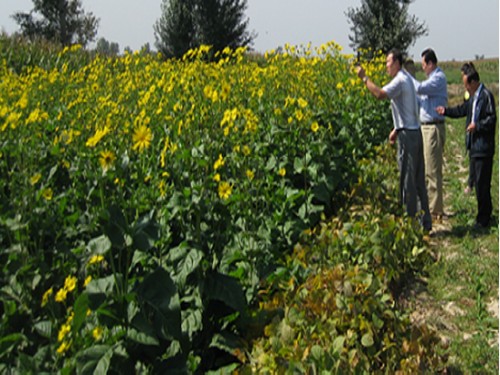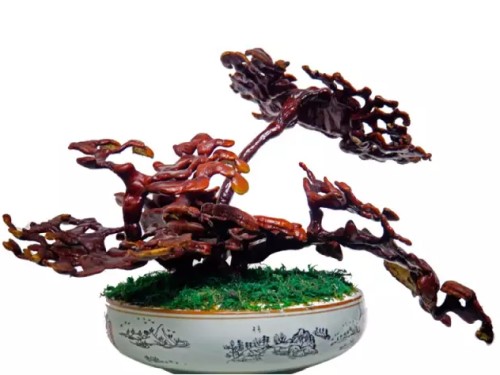Planting technique of Pinus elliottii
Cuihu Wetland Park has a beautiful flower whose posture is similar to that of chrysanthemum. Yellow flowers bloom in pieces, making people feel cheerful. Its name is Pine and Vanilla with leaves.
Rosaceae, alias chrysanthemum, cup grass, French champagne, etc., belongs to the perennial herb of Compositae. It is native to the humid high steppe of central North America and was introduced into Europe from the United States in the 18th century. it is a courtyard ornamental plant; in the early 1950s, the former Soviet Union began to study it as feed, and then introduced it to North Korea; in 1979, Beijing Botanical Garden introduced it to China from the Central Botanical Garden in Pyongyang, Korea. Because the base of the opposite leaf on the stem is cup-shaped, and the stem runs through the middle of the two leaves, it is named string-leaf pine vanilla.
Cross-leaf pine vanilla is high in protein and rich in a variety of amino acids, especially lysine. It is a high-yield and high-quality feed crop. It is also a guardian of high-quality green manure and soil and water conservation. Trifoliate pine vanilla has tall plants, broad stems and leaves and golden flowers. It is an ideal ornamental plant and nectar plant for beautification and greening, and it also has good medicinal value.

[land selection and preparation]
1. Site selection: the height of cross-leaf pine vanilla is generally 2-3 meters, with a maximum of 3.5 meters. It likes plenty of sunshine and humid and fertile soil with deep soil layer, and its suitable PH value is 6.5-7.5. It is not resistant to barren and waterlogging, so it should try its best to choose plots with fertile soil and no stagnant water. The stem is brittle and easy to break, so we should pay attention to choose the sunny land which is sheltered from the wind or has a barrier.
2. Soil preparation and fertilization: after leveling the ground, rosin grass is required to form loose soil without large clods. After germination, the top soil force of the seedling is not strong and the root system is well developed. deep ploughing must be carried out before sowing, and sufficient base fertilizer must be applied. 2000-4000 kg of mature barnyard manure, 60-80 kg of urea and 30-50 kg of superphosphate should be applied per mu, and fine soil preparation should be carried out to ensure smooth border surface and dig box ditch and waist ditch to ensure good irrigation and drainage in the field.
[sowing technology]
1. Sowing time: cross-leaf pine vanilla can be sowed all the year round when the temperature is above 5 ℃, among which spring and autumn sowing are the most suitable. It is suitable for spring sowing from mid-February to mid-March and from early September to early October for autumn sowing.
2. Sowing method: seedlings can be raised and transplanted, or direct seeding can be carried out. Live broadcast can be broadcast or broadcast.
3. Sowing rate: cross-leaf pine vanilla can not only be sowed by strip or on demand, but also can be planted and transplanted. generally, the sowing amount of strip sowing or on-demand sowing is about 0.2 kg per mu, and the seedling transplanting can transplant 10 to 12 mu per kilogram of seeds, and the sowing depth is about 2 cm.
4. Sowing: fine seed selection before sowing and drying for 2-3 hours to promote seed germination. Then soak in 30-35 ℃ lukewarm water and drain.
The main results are as follows: (1) adopt the method of seedling transplanting and planting: finely straighten the seedling bed, then spread the treated seeds evenly on the seedling bed, use 1 kg of seed per 10 meters, then cover with 1cm fine soil, and often spray water to keep the soil surface moist. Seed sowing method can also be adopted for seedling raising, that is, a seed (tip down, gap end up) can be inserted into the soil one by one, until the seed is completely lost by the soil cover. The amount of seed is the least, but the germination rate is the highest. When the seedlings grow 4 true leaves or the leaves are about 30 cm long, they can be transplanted to the planting land. The row spacing is 50-60 cm and the plant spacing is 40-50 cm. It is generally appropriate to keep about 5000 effective seedlings per mu. If it is used to harvest seeds, it is generally required that the row spacing is 150-200cm and the plant spacing is 50-60cm.
(2) seed direct seeding: hole sowing method can be used, 3-4 seeds per hole, seedlings after emergence, keeping 1-2 plants per hole. In order to ensure full germination, cover the soil after sowing and frequently increase irrigation to keep the soil moist. When the seedlings grow 4 true leaves or the leaves are about 30 cm long, five or six thousand plants per mu are more suitable. Strip broadcasting can also be carried out with a line spacing of 50 to 60 centimeters and a broadcast area of 20 × 20 centimeters.
[field management]
1. Irrigation and fertilization: the cotyledons of Rosin rosewood are hypertrophic and difficult to be unearthed. Before sowing, the topsoil should be kept moist and the border smooth. Generally, seedlings can emerge 4-5 days after sowing. After the seedlings come out, they should be irrigated and watered in time and applied with available nitrogen fertilizer. 10 kg urea per mu can be applied to promote the rapid growth of seedlings, but at this time, attention should be paid to field drainage and waterlogging. Prevent the occurrence of rotten roots and dead seedlings caused by continuous stagnant water in the field. Before turning green in early spring or after each cutting, ploughing and fertilization should be carried out in time to maintain sufficient water and fertilizer, and interplanting legume green manure such as Arrow tongue pea and Arrow tongue pea can also be used to improve soil fertility.
2. Control weeds: in general, sterilized herbicides such as diuron, pentachlorophenol sodium and glyphosate can be sprayed before sowing in cultivated land, and then sowed in cultivated land after 7-10 days, so that the harm of weeds in seedling stage can be effectively controlled, and the growth of weeds can be inhibited competitively after rosin grass grows.
3. Prevention and control of diseases and insect pests: there are generally no obvious diseases and insect pests in the whole growing period, but in order to prevent pathogenic microorganisms such as fungi in the soil from harming the wound after cutting, carbendazim solution can be sprayed in advance before cutting and utilization.
[cutting utilization]
Cross-leaf pine vanilla not only has high fresh grass yield and good quality, but also is rich in various nutrients, especially high crude protein content. Generally, under the condition of sufficient water and fertilizer, the seeds were sown in the spring of that year, and cut for the first time in early June, and then cut every 20 to 30 days. The yield of fresh grass was about 3000 kg per mu in that year and 1000015000 kg per mu in the next year. Nitrogen fertilizer was applied in time after each cutting to ensure a higher yield.
[seed harvesting]
The flowering period of rosin grass is long, the seed maturation is inconsistent, and the seed is easy to fall off after maturation. It should be harvested when the seed is black-brown and does not crack, and should be picked along with ripening. Its stem is tender and crisp and is easy to be broken. Great attention should be paid to collecting seeds so as not to affect the seed yield. Generally, the yield is 35-50 kg per mu, up to 75 kg.
"Cross-leaf pine vanilla" is a perennial perennial herb of Compositae, native to Canada and the United States. It is resistant to cold and high temperature. it has no frost damage under-29 ℃ in winter and can grow normally under the temperature of 40 ℃ in summer. It can be planted in many areas and has a wide range of applications.
The stem of "cross-leaf pine vanilla" is stout and tall, the stem in the growing period is crisp and succulent, and the yield of fresh grass is high. The yield per mu of cultivated year is 1000-3000 kg, and that of the next year and the third year can reach 1-15000 kg per mu.
Cross-leaf pine vanilla is of good quality, large leaf quantity, tender and succulent, rich in nutrition (see table below), good protein quality, containing 17 kinds of amino acids, complete essential amino acids and high lysine content. It is a high-quality forage grass for feeding pigs, cattle, sheep, ostriches and so on. The regeneration ability is strong, and it can be cut 4-6 times a year. The annual output of grass is generally 10000kg to 15000kg. Under general conditions, it can grow for 10 ~ 12 years, and under good cultivation management and reasonable cutting conditions, the growth period can reach 15 years or more, which is not only suitable for large and medium-sized intensive production, but also can be planted on sporadic ground in front and back of the house.
Key points of cultivation techniques:
1. Spring sowing from March to May and autumn sowing from August to October, the germination temperature is 10-15 ℃, and the suitable growth temperature is 15-30 ℃. Before sowing, the seeds should be sunned for 2 hours, then soaked in 25 ℃ warm water for 12 hours, dried, then evenly mixed with moist fine sand, placed in 20 ℃ room for 3 hours and 4 days, and sowed after most of the seeds were exposed.
2. Choose ventilated sunny and fertile loam as seedbed, the width of the bed is 1.3-2 meters, the width of the ditch is 0.3 meters, the soil should be knocked fine, the surface of the border should be flat, and the basic fertilizer should be applied. Before sowing, use thin human feces and urine as the bottom, applying about 1000 kg per mu of seedling bed. After watering water and fertilizer, sow seeds evenly at an interspecific distance of 5 cm, sow at a depth of 1.5 cm, cover with a layer of charred mud and fine soil, and then cover with straw. Spray water frequently and keep it moist. After the seedlings come out, remove the mulch. If the autumn sowing is too late and the seedlings are small and tender, they should be covered with plastic film to facilitate their growth in the following year.
3. Cross-leaf pine vanilla has strong fertilizer tolerance, 2500 kg of fence fertilizer, 50 kg of phosphate fertilizer and 15 kg of standard nitrogen fertilizer are applied per mu before transplanting. For each green cutting, 10 kg / mu of standard nitrogen fertilizer was applied. After one year, fence fertilizer, phosphorus fertilizer and nitrogen fertilizer should be applied continuously to supplement and maintain the fertility of the soil.
4. weeding should be done in time during the seedling raising period, and irrigation should be often used during drought to keep the soil moist. Due to the slow growth at the initial stage, attention should also be paid to ploughing and weeding. In order to improve fertility, legume green manure crops such as Arrow tongue pea and Arrow tongue pea can be interplanted in rosin grass fields.
5. Pinus elliottii has strong disease resistance and less diseases and insect pests. Sometimes the corn borer is invaded by the corn borer in the flower bud stage, which can be killed by 1000 times trichlorfon. If powdery mildew occurs in the seedling stage, the lime-sulfur mixture of about 0.5 degrees Baume should be sprayed in time to prevent and control.
6. There are two methods of cutting, one is to cut off at one time (leaving stubble 125px or so), the other is to pay attention to the leaves while cutting, the latter is better and has a good grass yield. Cut every 20-30 days, cut 8-10 times in the second and third years, and produce more than 15000 kg of fresh grass per mu.
The nutritional composition of cross-leaf pine vanilla is very good, and the dry matter content is 23.6% of crude protein. Crude fat 3.51%, crude fiber 26.27%, crude ash 1.87%, nitrogen-free extract 46.7%, calcium 3.33%, phosphorus 0.28%. The digestibility is also good, and the digestibility of protein is 83%. The utilization methods include fresh grass, fermentation, silage and hay.
The fresh grass of cross-leaf pine vanilla can be fed directly to cattle, sheep, rabbits, chickens, geese and so on. At the beginning of feeding, some livestock and poultry do not like to eat or do not eat, can be made into feed cakes, pieces to feed. Hay powder production method: the fresh grass will be sun-dried, air-dried, dehydrated and then crushed into grass powder, generally 5-6 jacks to make 1 jin.
Time: 2019-05-24 Click:
- Prev

Cultivation techniques of Ganoderma lucidum bonsai
Ganoderma lucidum bonsai is a kind of stereotyped handicraft made from mature dried Ganoderma lucidum in recent years. The use of foam plastic greenhouse technology will be in the growth stage of Ganoderma lucidum live pot to make live Ganoderma lucidum bonsai, like potted flowers, can be seen Ganoderma lucidum seedling stalk elongation
- Next

How to grow garlic vines
Garlic vines are native to South America, Guyana and Brazil, and are distributed in South China. Because of its dense branches and leaves, colorful flowers and strong garlic flavor, insects avoid them, so there are few obvious diseases and insect pests in cultivation, which can be used for ground planting, potted plants or for decoration of fences, fences, pavilions and scaffolding.
Related
- Fuxing push coffee new agricultural production and marketing class: lack of small-scale processing plants
- Jujube rice field leisure farm deep ploughing Yilan for five years to create a space for organic food and play
- Nongyu Farm-A trial of organic papaya for brave women with advanced technology
- Four points for attention in the prevention and control of diseases and insect pests of edible fungi
- How to add nutrient solution to Edible Fungi
- Is there any good way to control edible fungus mites?
- Open Inoculation Technology of Edible Fungi
- Is there any clever way to use fertilizer for edible fungus in winter?
- What agents are used to kill the pathogens of edible fungi in the mushroom shed?
- Rapid drying of Edible Fungi

